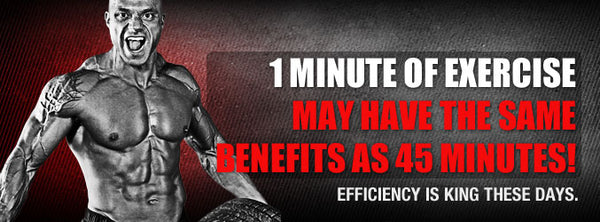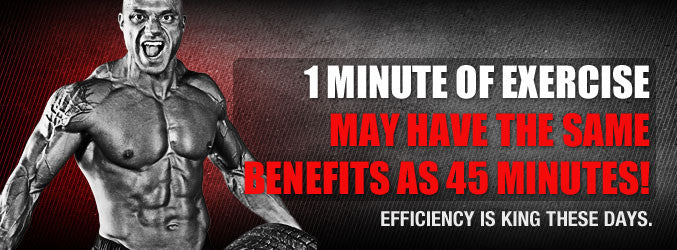
We live in a very competitive world. With the advent of the internet taking over our lives some 15 to 20 years ago, communication across the globe became instantaneous. Oceans, mountains, and distance, the entities which once created limitations to communication, cooperation, and growth, were suddenly removed, allowing people to trade ideas, exchange currency, make deals, and work together (and against one another) for the first time. Our generation is the first to place an extreme emphasis upon efficiency more than at any other time in human history. You complete effectively and efficiently using your limited resources (the most important of which is time), or you lose – in the global marketplace, in the boardroom, in the classroom, and everywhere else. Efficiency is king these days.
This week, the NY Times set the fitness world on fire with a new article detailing an experiment showing 60 seconds of very strenuous exercise being just as successful at 45 minutes of moderate exercise, for reaching health and fitness goals. You read that correctly: One minute of “all out” training delivered the same health and fitness results as 45 minutes of moderate training.

Now, obviously, the idea of interval training has been around for a very long time. Athletes will train at near-maximum capacity for one minute, then walk for one minute. Repeated for 18 to 30 minutes, the athlete is able to achieve a working heart rate near maximum capacity for the full amount of time, while avoiding the expected muscle failure which would accompany a full-out workout for the entire session. This training philosophy is very popular with newbie athletes, all the way up to elite trainers.
Digging deeper, we learn the details of this training experiment discussed by the New York Times. Three groups of untrained individuals were put to the test. Their aerobic levels were tested, as were their muscle mass using biopsies. Group A was given zero training, and at the end of the 12-week session, saw no change to their fitness or muscle levels. That is to be expected. Group B was trained for 12 weeks using a standard endurance-style program of multiple 45-minute stationary bicycle rides each week, at a moderate pace. They saw improved muscle strength and stamina, as well as many other cardiovascular benefits. You know, the usual gains when people that don’t train, start to train – moderately.

Things got really interesting when Group C started training. They trained for 12 weeks as well, using a far briefer protocol in the gym. They used workouts which only lasted TEN minutes. They warmed up for 2 minutes, pedaled “all out” for 20 seconds. Moderate pedaling for 2 minutes, than “all out” pedaling for 20 seconds. Two more minutes of moderate riding, then “all out” for a final 20 seconds. Then, they pedaled moderately for a cool-down period of 3 minutes. Out of the gym in under 10 minutes, with only 60 seconds of this training session dedicated to ALL OUT pedaling at near 100% physical capacity.
The surprise came when the 12-week results for the Group C arrived… showing their gains in terms of muscle, fitness, and stamina were IDENTICAL to Group B. They spent 10 minutes in the gym, and 1 minute at peak capacity training. The other group spent 45 minutes in the gym training at a steady moderate rate, and made the exact same gains! In a world based upon efficiency, you can quickly realize why this study made huge headlines in the mainstream media. This turns everything we’ve ever assumed about fitness and training on its head. Can we really make the same gains, in less time, by adding more intensity? The study’s results say YES!
Let’s stop for a moment and decide if this training strategy might be right for you. If you enjoy long training sessions, then you shouldn’t change a thing. If you’re pressed for time and regularly missing workouts because you don’t have 45 or more minutes to train, then an abbreviated training session might just be a good move for you. If you just want to find better ways to use your time, then yes, you may want to give this training protocol a try. If you have sore joints and aching muscles from a demanding job or just spending.

First you will want to set very clear goals, divided into categories. Strength, muscle size, body fat level, and endurance/stamina are good places to start. Record your current levels, then tackle a short-term foray into 1-minute, all-out training. Apply it for 4-6 weeks, giving your body a huge break. At the end of this time, decide if the results you are seeing are satisfactory for your expectations.
Remember that this experiment was done using text subjects who were essentially untrained. Elite athetes, or even intermediate trainers, who have spent years in the gym, may actually lose some of their gains if they’re accustomed to training with weights for an hour a day, 4-5 times each week. Recording your progress in a training journal will allow you to quickly ascertain if your results are staying steady. List your measurements, weights/sets/reps used, scale weight, and of course, take the dreaded mirror selfies to record visual proof of your gains (or lack thereof).
As always, the best training philosophy is going to be the one you are not currently using. Mix things up! Continue on your path. Seek every possible sustainable competitive advantage in everything you do. Seek efficiency in your processes and effectiveness in your means. Apply the new lessons you learn each day. Test your new hypothesizes, and see if they work for you. In the end, you’ll have a clearer understanding of how your body works, and how it responds to various training approaches. Best wishes!


